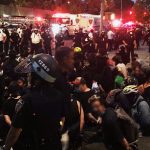In the year since George Floyd’s murder, the American public has caught glimpses of the profound traumas experienced by those who witness police violence. As medical professionals, we have seen how excessive force used by police impacts not only the people directly harmed, but also bystanders, families, and neighborhoods, long after the TV cameras are turned off.
The physical tolls of broken bones, nerve damage, or asphyxia at the hands of police are plain to see. But survivors are often left coping with severe psychological injuries as well. The medical field is increasingly recognizing that the psychological traumas from police violence extend far beyond the individual and can reach entire communities.
As New York reckons with legacies of structural racism and present-day abuses by police, we must view policing through the lens of collective trauma and start the difficult but essential steps required to repair the damage.
One example of what is known as “collective trauma” was the byproduct of actions one year ago today by the New York City Police Department (NYPD) in the Mott Haven neighborhood of the Bronx. Against the backdrop of nationwide racial justice demonstrations, an anti-police violence protest began in Mott Haven – a predominantly Black and brown neighborhood – on the evening of June 4, 2020. Just the citywide curfew began, the NYPD kettled – encircled– some 300 protestors and prevented their dispersal. Police officers then climbed onto vehicles, punched, kicked, beat people with batons, dragged people through the streets, and launched tear gas and rubber bullets. The NYPD reportedly arrested 263 people, including legal observers and medics. At the height of the pandemic in New York, police crammed large groups of people into vans and small holding cells for hours, removing the facial masks of some of the detained. Medical care for protestors’ injuries was reportedly blocked. An earlier Physicians for Human Rights investigation – conducted independently from ours – found that medical care for protestors’ injuries was blocked by police.
In September, a landmark investigation by Human Rights Watch found that the NYPD “planned the assault and mass arrests of peaceful protesters,” with the premeditated actions “led by the department’s highest-ranking uniformed officer.” Investigators concluded that the Mott Haven crackdown was “among the most aggressive police responses to protests across the United States following the police killing of George Floyd.”
We have dedicated our careers to the study and clinical treatment of survivors of traumatic human rights abuses. The Bronx Defenders, a Bronx-based legal assistance nonprofit organization that represents 23 of the Mott Haven protestors, asked us to conduct an independent analysis of the physical and psychological consequences of the individual and community-level trauma stemming from these police actions. In January, the Mott Haven Collective sent a demand letter to the City of New York calling for the creation of a community reparations fund in the Bronx in response to the June 4 police violence.
After analyzing the 23 protestors’ Notices of Claim – a two-page form used to notify the City that someone intends to file a lawsuit against a city agency – it is our expert opinion that protestors’ experiences meet the diagnostic criteria for “traumatic events,” as defined by the American Psychiatric Association. Nineteen of the 23 claimants described experiencing cardinal symptoms of post-traumatic stress disorder, depression, or anxiety since the events at the Mott Haven protest. Even protestors who were not themselves physically harmed that night – but who saw their friends and peers shot with rubber bullets and beaten with batons – now grapple with mental health issues.
Police violence harms families and communities by contributing to a climate of fear, chronic stress, and lowered resistance to diseases, even among those not directly harmed by police. A 2018 study found that some 38% of Black respondents had been exposed to one or more police killings of unarmed Black people in their state in the previous three months. Each additional killing was associated with significantly more additional poor mental health days among these respondents.
Police violence harms families and communities by contributing to a climate of fear, chronic stress, and lowered resistance to diseases, even among those not directly harmed by police.
Collective trauma in communities that have historically suffered from experiencing and witnessing police violence compounds itself when it occurs constantly. The violence on June 4 can be expected to have an even larger impact on the community because it is just one event in a long history of structural racism in the Bronx.
So, how do we begin to repair this damage and heal these scars?
The first question to ask is what the community favors as an adequate reparative process. In Mott Haven, a coalition of community organizations and residents should decide whether such a process includes atonement, monetary compensation for victims, health and mental health services, holding police who acted in illegal ways accountable, or diverting funds from the police to other community services. Guided by this coalition, City officials should provide substantial financial support and resources to the injured protestors and the broader Mott Haven community.
As clinicians, we see in our work with survivors of state violence and in medical literature the individual and community-level impacts of trauma. As New York reckons with legacies of structural racism and present-day abuses by police, we must view policing through the lens of collective trauma and start the difficult but essential steps required to repair the damage.

